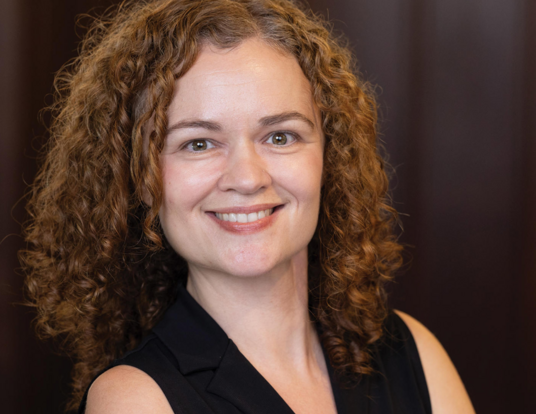A Fascination with Perspective
How Katherine van Schaik connects history and medicine

Katherine van Schaik has always been fascinated with perspective. As an undergraduate at Harvard College concentrating in the classics with a secondary field certificate in molecular biology, she wrote a thesis on religious art, exploring how diverse audiences perceive different messages in the iconography. This interest in interdisciplinary study did not disappear when Van Schaik entered GSAS, where she pursued an MD at Harvard Medical School alongside a PhD in ancient history in the Department of the Classics.
“As I moved along in my medical education, this desire to understand the concept of perspective became a question of, ‘How do we define disease, and whose perspective is contributing to that definition?’” she says.
Currently, Van Schaik is balancing three different projects: finishing her medical education; wrapping up her medical honors thesis on paleopathology; and defending her PhD research, which explores diagnostic, prognostic, and therapeutic decision-making in Greco-Roman medicine. To an outsider, these three endeavors may seem distinct from one another, but for Van Schaik, they all relate to her fascination with perspective and its role in medicine.
Studying Perspective
As part of her research, Van Schaik is investigating medical decision-making in Greco-Roman antiquity by looking at models of disease diagnosis and classification used in the ancient world. Various groups of physicians ascribed to very different methodological persuasions, and Van Schaik is interested in seeing how these methodologies shaped physicians’ views of how to define and treat disease.
Van Schaik gives two examples of rival approaches. Galen, a prominent Greek physician in the Roman Empire who wrote extensively about medicine, focused on identifying an individual’s humoral balances, habits, lifestyle, and preferences. The Methodists, who were named after their methods of healing, followed a less personalized approach, emphasizing the physiological and anatomical similarities between people and seeing disease as a deviation from a more generalized norm.
While Van Schaik’s research focuses on antiquity, it has also influenced how she, as a soon-to-be physician, understands current medical methodologies. “Guidelines and classification systems can prevent cognitive error and help physicians to be more aware of the many details that could factor into a diagnosis or treatment plan,” Van Schaik explains. “At the same time, as a historian, I know that many people have been convinced of the correctness of their methods. I hope this knowledge helps me approach clinical practice with humility and the awareness that methods change.”
Mummies and Methodologies
When Van Schaik gives the four-second version of her medical honors thesis research, she calls it “Mummy CTs,” referring to computed tomography scans, which are used to create cross-sectional images of the body. “The work that I actually do is not that straightforward,” Van Schaik confesses. Studying human remains allows researchers to investigate what the burden of disease was in the past, and the outcomes of these investigations have real clinical implications in contemporary medicine. But it’s important to understand the strengths and limitations of the methodologies used to study these bones.
Collaborating with an osteologist at the Museum of London and a radiologist at Beth Israel Deaconess Medical Center (BIDMC) in Boston, Van Schaik is examining 19th-century skeletons to compare two paleopathology techniques: radiographs and osteological analyses. “One of the crucial elements of osteological analysis is the tactile sensation of the bone,” Van Schaik explains. “What does the surface of the bone feel like? Does it feel like there is evidence of infection?” But sometimes, Van Schaik cautions, what an osteologist feels when touching a bone can be related to the environment in which the bones were buried, and discerning the difference between a feeling caused by disease versus one caused by the environment can be difficult. A radiologist, on the other hand, does not touch the bone itself and, instead, must discern lesions and disease entirely from X-ray images.
“In radiology, you would say ‘to overcall something’ means to be more willing to identify a lesion,” Van Schaik says. “To ‘undercall’ means you’re less willing to identify a lesion,” she adds. Van Schaik is interested in seeing whether one or the other modality has a tendency to overcall or undercall. “The solution may be an analysis that involves an osteologist and a radiologist looking at all the evidence together before making a decision,” Van Schaik explains. “Maybe this is the refrain of my research, but it’s a question of perspective.”
The Perfect Match
On Match Day, the day in March when medical students find out where they will be doing their residencies, Van Schaik was matched with the radiology department at BIDMC, where she has been working on this project since 2015. Being at BIDMC, a Harvard Medical School teaching hospital, will allow Van Schaik to continue to balance her love for both historical research and modern medicine. Radiology also has its own deep well of perspectives. “There are a number of modalities you can use to answer a question: X-rays, CT scans, MRI, ultrasound, molecular imaging,” she says. One of the challenges of radiology is that the modality you choose will affect the answer you get, but Van Schaik does not shy away from that challenge. “I love being able to approach a question from all of these different angles, and I love the process of asking a question and answering it using the appropriate instrument,” she says. Once again, for Van Schaik, it all comes back to the importance of perspective.
Get the Latest Updates
Join Our Newsletter
Subscribe to Colloquy Podcast
Simplecast




